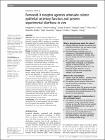| dc.contributor.author | FALLON, PADRAIC | en |
| dc.date.accessioned | 2015-12-11T12:05:09Z | |
| dc.date.available | 2015-12-11T12:05:09Z | |
| dc.date.issued | 2014 | en |
| dc.date.submitted | 2014 | en |
| dc.identifier.citation | Mroz MS, Keating N, Ward JB, Sarker R, Amu S, Aviello G, Donowitz M, Fallon PG, Keely SJ., Farnesoid X receptor agonists attenuate colonic epithelial secretory function and prevent experimental diarrhoea in vivo., Gut, 63, 2014, 808 - 817 | en |
| dc.identifier.other | Y | en |
| dc.identifier.uri | http://hdl.handle.net/2262/75279 | |
| dc.description | PUBLISHED | en |
| dc.description.abstract | OBJECTIVE:
Bile acids are important regulators of intestinal physiology, and the nuclear bile acid receptor, farnesoid X receptor (FXR), is emerging as a promising therapeutic target for several intestinal disorders. Here, we investigated a role for FXR in regulating intestinal fluid and electrolyte transport and the potential for FXR agonists in treating diarrhoeal diseases.
DESIGN:
Electrogenic ion transport was measured as changes in short-circuit current across voltage-clamped T84 cell monolayers or mouse tissues in Ussing chambers. NHE3 activity was measured as BCECF fluorescence in Caco-2 cells. Protein expression was measured by immunoblotting and cell surface biotinylation. Antidiarrhoeal efficacy of GW4064 was assessed using two in vivo mouse models: the ovalbumin-induced diarrhoea model and cholera toxin (CTX)-induced intestinal fluid accumulation.
RESULTS:
GW4064 (5 μmol/L; 24 h), a specific FXR agonist, induced nuclear translocation of the receptor in T84 cells and attenuated Cl(-) secretory responses to both Ca(2+) and cAMP-dependent agonists. GW4064 also prevented agonist-induced inhibition of NHE3 in Caco-2 cells. In mice, intraperitoneal administration of GW4064 (50 mg/mL) also inhibited Ca(2+) and cAMP-dependent secretory responses across ex vivo colonic tissues and prevented ovalbumin-induced diarrhoea and CTX-induced intestinal fluid accumulation in vivo. At the molecular level, FXR activation attenuated apical Cl(-) currents by inhibiting expression of cystic fibrosis transmembrane conductance regulator channels and inhibited basolateral Na(+)/K(+)-ATPase activity without altering expression of the protein.
CONCLUSIONS:
These data reveal a novel antisecretory role for the FXR in colonic epithelial cells and suggest that FXR agonists have excellent potential for development as a new class of antidiarrheal drugs. | en |
| dc.format.extent | 808 | en |
| dc.format.extent | 817 | en |
| dc.language.iso | en | en |
| dc.relation.ispartofseries | Gut | en |
| dc.relation.ispartofseries | 63 | en |
| dc.rights | Y | en |
| dc.subject | Bile Acid | en |
| dc.subject | Cell Biology | en |
| dc.subject | Diarrhoea | en |
| dc.subject | Epithelial Transport | en |
| dc.subject | Intestinal Ion Transport | en |
| dc.title | Farnesoid X receptor agonists attenuate colonic epithelial secretory function and prevent experimental diarrhoea in vivo. | en |
| dc.type | Journal Article | en |
| dc.contributor.sponsor | Science Foundation Ireland (SFI) | en |
| dc.type.supercollection | scholarly_publications | en |
| dc.type.supercollection | refereed_publications | en |
| dc.identifier.peoplefinderurl | http://people.tcd.ie/pfallon | en |
| dc.identifier.rssinternalid | 96747 | en |
| dc.identifier.doi | http://dx.doi.org/10.1136/gutjnl-2013-305088 | en |
| dc.rights.ecaccessrights | openAccess | |
| dc.subject.TCDTheme | Immunology, Inflammation & Infection | en |
| dc.subject.TCDTag | Biomedical sciences | en |




